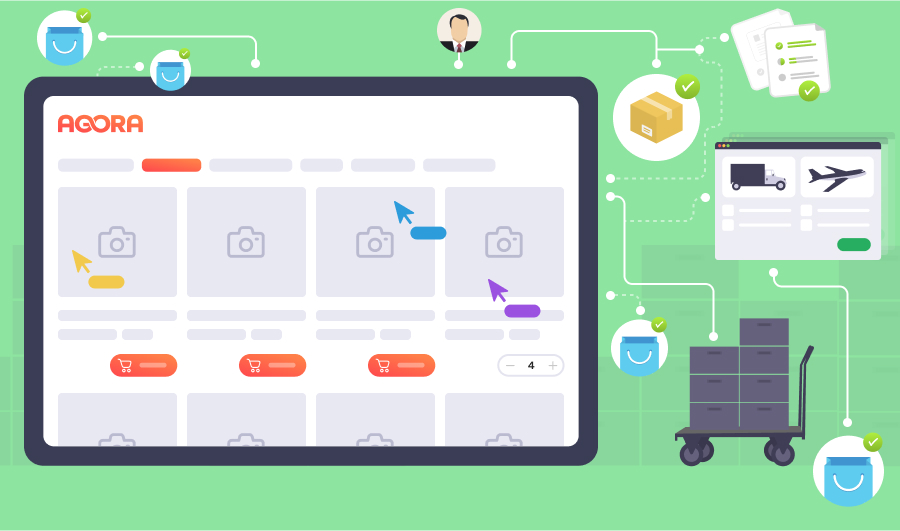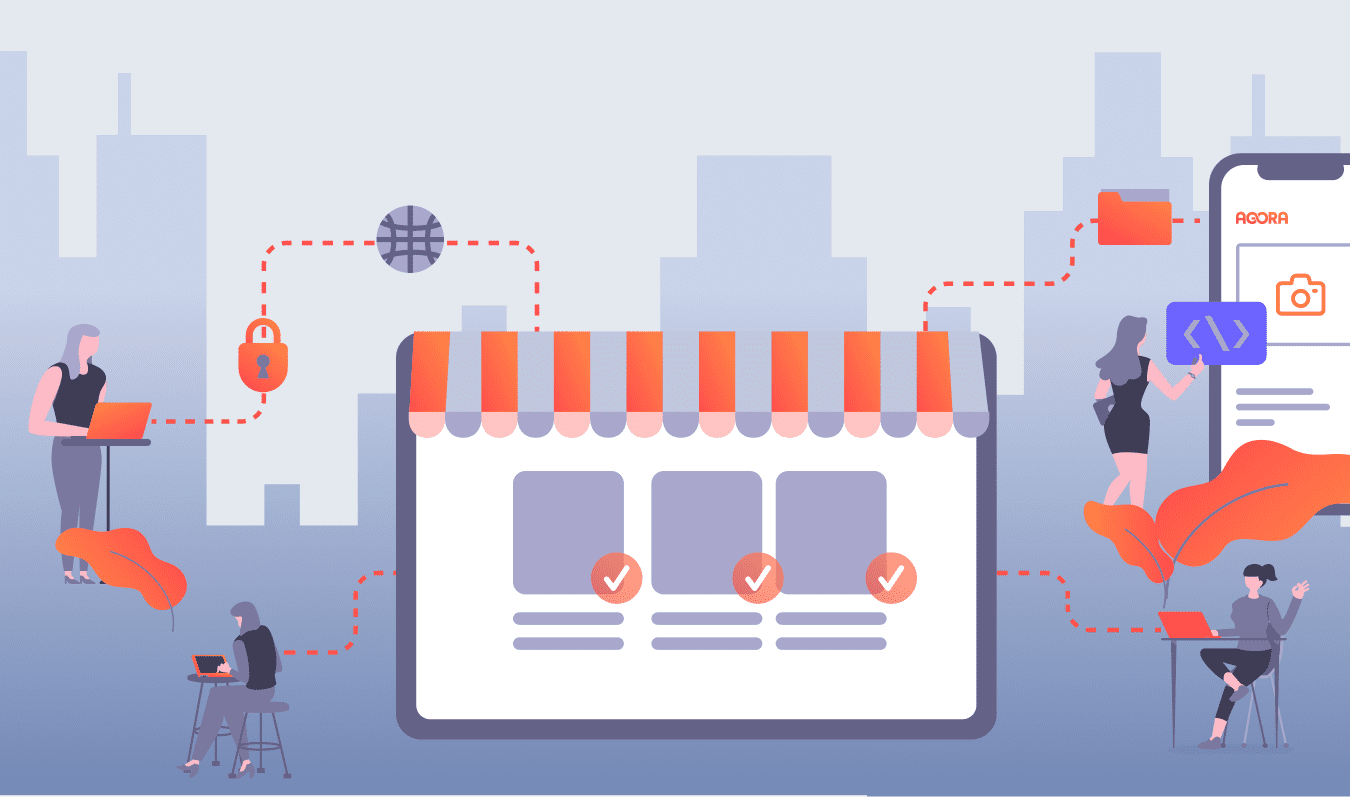
How to create an electronic trading platform
An electronic trading platform enlarges a company's opportunities to work with providers and customers. Displacement of sales and other business processes to an online platform reduces the company's operating costs, releases staff from mechanical tasks, and improves efficiency and labor productivity. In total, all of this leads to sales increase and income growth in the company.
What types of electronic trading platforms are there?
Depending on the type of clients — companies or individuals — electronic trading platforms are divided into b2c and b2b models.
While the first model is a regular retail electronic trading platform, the second one is more complex. In wholesale sales customers are often both purchasers and suppliers of goods, discounts are calculated by complex ratios and there are many different terms and conditions of transaction and product delivery.
Each of these models is divided into several types:
- Сlassifier (classified) is a website for advertisements. The feature of an electronic board is that deal isn’t made within the system: the customer just finds the contact details of the seller, directly contacts him, and purchases at his own risk. Classifiers earn money from advertising, ranking users, and promoting ads to the top. This model is quite profitable, but it requires much effort to promote the brand and attract traffic. Therefore the classifiers advance a long time.
- An online marketplace is a multivendor e-commerce platform. Many third-party sellers present their products on this platform. These trading platforms work in both the b2c and b2b markets and attract customers with a wide product range, price comparison opportunities, and quick similar products search. Marketplaces are usually the deal space. As a rule, they have many functions and represent large and expensive projects. The retail model is relatively uncomplicated. The wholesale model can involve multi-factor transaction management schemes ranging from complex pricing and discounts to payment terms, order formation, shipment, and delivery. One of these types of popular projects is Amazon. Types of marketplaces are platforms for electronic biddings and low-value purchasing.
- An electronic bidding platform is a possible version of a marketplace where bidding takes place for the purchase of any goods or services. There are several types of bidding on such platforms: price request (the lowest price is chosen), request for proposal (the best terms), competition between suppliers and reductions (bidding for lower prices). A specialized platform, such as AGORAB2B, allows for all types of bidding within a single electronic trading platform.
- A low-value purchasing platform is a marketplace model for large customers, where they make purchases with quite small (for their scale) transactions. As a rule, both e-bidding and low-value purchasing platforms are developed for one or two large customers who other suppliers follow in the marketplace. Several types of e-platforms are more successful in the retail market for various reasons, but due to the c2c model, where an individual interacts with another one.
- A collaborative purchasing platform is a portal that offers retail customers the opportunity to buy goods on a purchaser's terms (at a wholesale price). One of the customers creates a group for collaborative purchases and respectively is a mediator in the transaction. Generally, the audience of such platforms isn’t large and development prospects are doubtful. Collaborative purchases attract few buyers due to:
- the complexity of the purchasing scheme and delivery conditions;
- the need for indeterminate waiting for all deal contributors to meet together;
- the unpredictability of the moment of payment ("when the group gathers");
- unavailability of the required goods (e.g., if a buyer needs a common, "popular" size of clothes or shoes, and only "non-mainstream" sizes are left in case of a purchase of the whole size range of the product);
- the requirement for the mediator in high responsibility and lack of financial interest in the transaction, etc.
There is no need for this type of marketplace in b2b, while it doesn’t generate income for the company.
- Sale of services marketplace. This type provides an opportunity to find quickly a contractor for some work, such as a manicurist, plumber, or handyman. Such sites are very popular in the c2c market and earn from the commission. Companies often work on such platforms, but the main audience of these marketplaces is individuals who act as both providers and buyers of services.
Electronic trading platforms: difficulties of launching
The simpler and clearer the trading platform model, the more difficult it is to launch it. The only reason is competition. Simple business models like the classifier, which are not difficult to think through and develop, have much higher competition and require more investment. They are much more difficult and expensive to promote and make popular on the market. Therefore, it is easier to launch such projects in a certain niche, where there is lower competition.
Complex models like the b2b portal have another problem. When creating a platform, you need to carefully consider the principle of its operation, take into account many details, calculate all discount ratios and types of transactions, and think over the relationship between various factors — such as payment terms, order formation, shipment, delivery.
Most often, such a model is conceived in one form in the beginning, but it is significantly modified during the launch, and it is almost wholly redone after implementation.
Therefore, if a company needs to create an electronic trading platform and chooses to develop a new product from scratch, it takes a lot of time and money.
You have to understand that you can earn on e-commerce platforms only after implementation and promotion. The faster the platform is launched, the faster the company will start making money on it. So companies that want to create an “ideal” product should be prepared to incur losses not only for creating an electronic trading platform but also until the solution is launched. There is also a risk that competitors will quickly launch a similar offer using a ready-made platform.
A ready-made marketplace model based on the AGORAB2B platform is a solution that allows you to get a few extra points in a highly competitive field. AGORAB2B has many advantages:
- quick launch and implementation (up to 14 days for customization and 3-6 months for promotion);
- affordable subscription price, that allows you to test an idea quickly and at a low cost;
- wide possibilities of customization and user settings;
- testing the functionality on many other companies that have already implemented such a platform;
- onboarding with the training of staff, suppliers and buyers to work with the new site;
- accelerated transition to sales automation and optimization of business processes;
- new b2b marketing and sales tools that allow you to interact with your audience more effectively ;
- fast scalability of the solution during the process of the company’s development.
A ready-made b2b solution based on the AGORAB2B platform allows the company to focus not on the expensive development of an “ideal” electronic product, but on attracting traffic, developing business, and searching for a scaling model.
How to create a trading platform on the Internet: a step-by-step plan.
If you are looking for a solution to creating an electronic trading platform based on a ready-made platform, then choosing AGORAB2B you have to make only a few steps.
- Identify your niche and the audience you will work with. As a rule, when the company transfers an existing business to an online platform, there are no problems with this: the customers are already known.
- Select the category of products you will work with. It is difficult to work with different types of goods because it is complicated to adapt the system and catalogs to all industries and categories of products and services at once. In addition, there is high competition with major market players.
- Choose the market (b2b or b2c) and the type of business model: classifier, marketplace, e-bidding platform, etc.
- Select the necessary functionality and sign a contract with AGORAB2B: we will offer a ready-made solution with the described user scenarios, which will simplify and speed up the launch and implementation of your platform.
- Launch the platform. At this stage, you will abandon several functions that you initially considered as necessary, and add a few new ones you did not immediately take into account. Ready-made modules of the AGORAB2B solution will allow you to do it quickly and without time spent on development.
- Use the onboarding service to implement the work model. AGORAB2B specialists will train your staff to work with the platform, and they can also call your suppliers and buyers to create accounts for them on the platform and teach them how to perform the necessary actions.
A ready-made AGORAB2B solution for creating and launching an electronic trading platform will be faster, more convenient, and ultimately more profitable than a product that you will develop yourself. At the same time, AGORAB2B will allow you to choose any relevant business model and test its operation in the selected market segment, with minimal effort, time and money.
Also read


